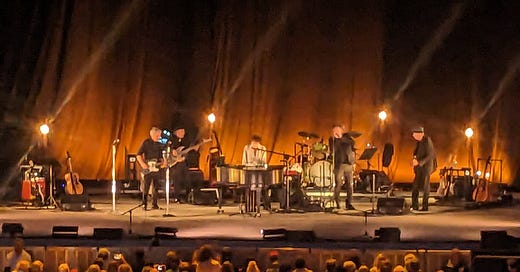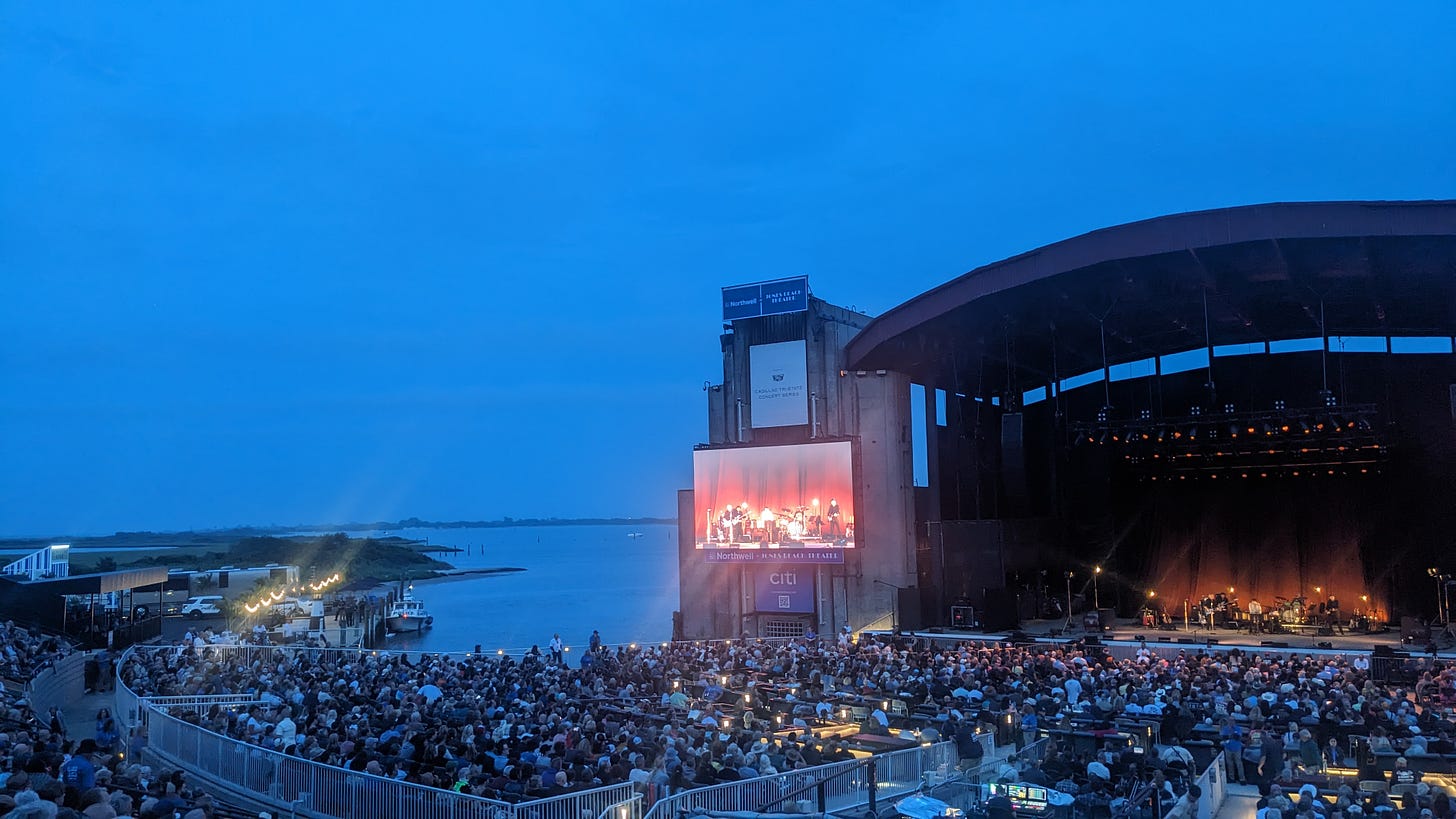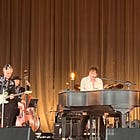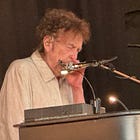Flagging Down the Double E’s is an email newsletter exploring Bob Dylan concerts throughout history. Some installments are free, some are for paid subscribers only. Sign up here:
Last night, the Outlaw Tour came to New York City. Well, technically, to Jones Beach, the waterfront amphitheater just outside of town. Music journalist extraordinaire Jesse Jarnow was on the scene and sends in this report. (Plus, as a bonus, some terrific videos have surfaced courtesy YouTuber @KellysConcertMemories).
Find the full list of Outlaw Tour dispatches here—five so far with two more coming in the next week. FYI most current-tour reports go to paid subscribers only.
Up came the fanfare and out came the band, flanking their leader, who entered the stage in an oversized white sweatshirt, hood up, and centered himself at his piano, itself pushed as far back from the stage lip as seemingly possible. Only then, as the musicians settled in their spots for the sixth stop of the Willie Nelson-less Outlaw Music Festival tour at Jones Beach on Long Island, did popular singer and boxing enthusiast Bob Dylan reveal his face and shrug out of his hoodie, placing it on a small keyboard perpendicular to his piano, repurposed as robe-stand for the band’s 70-minute set. New move? Maybe. Practicality of navigating from the tour bus to the stage without getting noticed? Probably. Long-brewing inner Bob character? Absolutely. Clue about a new direction, drop date of the next album, or setlist predictor? Consult your local boiled bird-guts.
Once known as the Jones Beach Marine Theater, the venue (and piece of Robert Moses graft) formerly featured a giant moat between seats and stage, where the orchestra section is now, originally intended for mock naval battles, water ballet, and lite bandleader Guy Lombardo. Artists made their entrance by boat, and one can imagine Dylan perhaps appreciating that option, had it still been available. With the amphitheater’s lovely fluted towers encrusted with video screens and corporate banners, the bay view has seen better days, but the vibe remains unmatched on a summer’s evening. At least if it’s not raining.
I was among those skeptical that Dylan’s sets this summer would shift in any drastic (or even minor) way after the declared end of the Rough and Rowdy Ways touring in the spring, expecting a few of the newer songs (at most) to disappear for a summer of shorter amphitheater gigs. After two wildly-shuffled performances to open the tour (with the debut of five new covers and accompanying conspiracy theories involving t-shirts advertising retconned tourdates), I was ready to hit the road. But with the show settling into a 15-song set, cooler heads prevailed, and the line of Bobological inquiry shifted from WTF?! to more considered questions about what it all means for him to play these songs now (and why all the motorcycle images, Bob)? At Jones Beach, at least, the answer was blowin’ in the pleasant sea breeze — it was fun.
And not just fun, but lots of different kinds of fun, the common thread being fun for Dylan himself, probably. The setlist shuffle can be heard as Dylan looking for his summer vibe to go along with his unbuttoned shirt. After a few years in his natural habitat of intimate theaters, the Outlaw Festival puts Dylan back in front of a broader crowd. Opening and closing with ‘60s classics (“Highway 61 Revisited” and “I’ll Be Your Baby Tonight,” respectively) seemed keyed to audience members who just came out for a nice evening with some music they might know.
The same might be said of the quartet of mostly new-to-Bob covers, adding not only variety, but further ways to invite in people who weren’t necessarily there just for Dylan. With a few nights to tighten the band, it seemed to work. The big this-is-obviously-a-Chuck-Berry-cover intro of “Little Queenie” brought instant cheers, and Dylan was so clearly having a gas singing it, leaning into the “meanwhile...” lead-in to the chorus as if it were as a novelistic (or comic book) scene change. Like every song, Dylan’s piano was the main lead instrument, filling in breaks and joyfully dancing/hopping/skipping across barlines, having finally learned to be his own Garcia. It was just fun music, fun to play, fun to sing, fun to hear, with no one laughing more than Dylan, seemingly cracking himself up with his own vocal delivery. I suspect that songs have sometimes returned to Bob Dylan’s active songbook not because there’s something about the lyrics that speak to the moment but because they’re appealing to perform, and why not?
Meanwhile, the 1958 Fleetwoods’ hit “Mr. Blue” had Dylan employing the soft and weird-dreamy voice of his own ballad era, but it served as the set’s literal slow dance. I spotted at least one couple doing just that in the aisle, and saw a similar video posted from an earlier show, and I don’t think it’s because these fans were psyched someone was finally covering the Fleetwoods. It was music that called them to dance at a mostly-sitting show. And if an audience member was just there because something called the “Outlaw Music Festival” sounded fun and didn’t know anything about Dylan, they’d almost certainly recognize “Six Days on the Road,” covered by everybody and the New Riders. And, Long Island being Grateful Dead country and all, for some portion of the audience, Jerry Garcia and Robert Hunter’s “Stella Blue” was an emotional centerpiece, the only cover in the set by musicians who were not only Dylan’s contemporaries but close friends. It, too, received multiple waves of mid-song cheers.
And the setlist was/is fun in the sense that Dylan also has a few new playing-for-keeps arrangements, including an almost-totally-solo “Can’t Wait” (in the mode of “Girl of the North Country” and other songs on recent tours) and a cool modernized “Under the Red Sky.” In a few limited cases, it was fun in the way that felt like Dylan was pulling on something familiar he started long ago. “Ballad of a Thin Man” maintained a line of continuous paranoid menace threading clearly to the high wild ’66 versions, perhaps because it was Dylan’s designated piano song before he (re)adopted keyboards as his main axe. Some of the night’s biggest cheers came when Dylan played harmonica (“Shooting Star,” “Early Roman Kings,” “Under the Red Sky,” “Soon After Midnight,” “Ballad of a Thin Man”), places where the musician onstage was absolutely unmistakably the human called Bob Dylan, no matter if one knew the name of the song.
Were the band members having as much fun as their gang leader? Bassist Tony Garnier might’ve been. But sometimes, fun is relative. Guitarists Bob Britt and Doug Lancio looked mega-cool while they flanked Dylan symmetrically, each posed in cool-guy guitar stances — which also happened to be the best positions to keep their eyes locked on the boss’s hands for most of the night. Jim Keltner, the 82-year-old new guy in the band, was great, too, though the thick air of Jones Beach dampened a bit of nuance and made the drummers’ kits sound like wet cardboard all night (and often the guitars, too). Dylan’s band is in conversation, both onstage in the moment and in the longer term over the course of the tour, and there were a few moments of miscommunication; the band landed “Thin Man” before Dylan was ready to end, resulting in a long drumless coda.
Someday, one hopes that any and all of Dylan’s tours might receive the loving curated treatments as ’75 and a few precious other years. When that happens, this tour’s disc will surely include a version of “Simple Twist of Fate” featuring lighter-than-light harmonica by Mickey Raphael from Willie Nelson’s band, who joined Dylan for the first time in Syracuse the night before Jones Beach and will hopefully continue to do so. This writer fantasizes about other songs on which Raphael might contribute, which leads all too quickly to fantasizing about what else this collection of musicians might do together, which is really just a fool’s errand.
Like the band, Dylan heads remain in conversation in the short term and the long term, part of a never-ending line of post-show shit-shooting and written-up Bob-watching. After two nights of setlist hijinx, it’s slightly sad to settle in for the long haul, only mitigated by the fact that, after playing them a few dozen times, it means that these songs will sound even more amazing by the end of this tour (and because someone will find the right circumstances to pull an awesome tape or two). Like always, Dylan heads are in no way in conversation with Dylan himself, so if Bob is looking for his hoodie, somebody tell him he left it on the keyboard.
Thanks Jesse! Find his many projects (pretty much all of which I consume myself and highly recommend) below.
Jesse Jarnow is the author of Heads: A Biography of Psychedelic America, Big Day Coming: Yo La Tengo and the Rise of Indie Rock, and Wasn’t That a Time: The Weavers, the Blacklist, and the Battle For the Soul of America. He co-hosts the official Good Ol’ Grateful Deadcast (which devoted a whole episode to one of the covers in this summer’s setlist) and hosts the Frow Show every Tuesday on WFMU (including the recent Bobsday 83 special). On Twitter sort of, but mainly Mastodon.
No tape yet but, as always, subscribers check the Discord for news of when one surfaces.









Really enjoyed this review - lots of great points and well-phrased observations.
I enjoyed the reference in there that we should all treasure something that someday (how far in the future can it be?) will not be available: the ability to just go to a venue and hear Bob Dylan sing, play harmonica, lead a band, pay piano, call the shots, sing his songs. How cool is it that we can still do that? That a denizen of Mansfield, MA (or nearby) gets to do that tomorrow?
Also, I am with you in musing on about how the NET might truly be curated into one or many box sets in the future by Sony. Why haven't they done it so far?
The only Dylan live album reflecting a NET show is MTV Unplugged 29 years ago, which doesn't really represent a Dylan NET show of course - not even a Dylan '94 show. Prior to that, we had 'Dylan And The Dead' which I bought the day it was released back in '89 - but doesn't count as a NET live LP of course because that tour was in '87.
Instead, we're left to assemble spicks and specks, as the Bee Gees would say, from those lovely live EPs released in the late 90s and early 00s, live cuts from box sets, bonus cuts on deluxe CDs, singles, the Bonnaroo '04 CD compilation, etc etc ... many random places.
There's no good reason not to release more of it. Springsteen has done a great job there, releasing all recent shows in great quality soon after they happen in recent years. The Allman Brothers Band took it one step further during their late reign, offering a soundboard CD of the show you were at - pay $25 when you walk in the show, walk out the door later that evening with the CD.
It's all doable. My guess is that Sony has stayed out of that in any formal way so far because they know the box set themes they've chosen have more appeal to many. Rolling Thunder beats NET, for most.
But to me, the NET is my favorite part of Dylan's whole oeuvre. Yeah, I said it! At least, in the sense that I listen to far more of his live music (via boots) from the NET than prior decades.
Anyway, there's more than a few over-baked thoughts on a topic I've pondered often! :)
That was a great read!